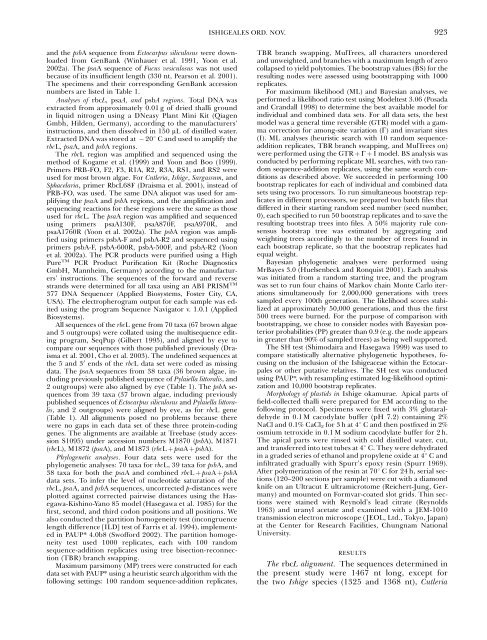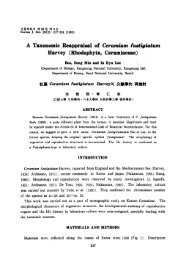A NEW BROWN ALGAL ORDER, ISHIGEALES (PHAEOPHYCEAE ...
A NEW BROWN ALGAL ORDER, ISHIGEALES (PHAEOPHYCEAE ...
A NEW BROWN ALGAL ORDER, ISHIGEALES (PHAEOPHYCEAE ...
You also want an ePaper? Increase the reach of your titles
YUMPU automatically turns print PDFs into web optimized ePapers that Google loves.
and the psbA sequence from Ectocarpus siliculosus were downloaded<br />
from GenBank (Winhauer et al. 1991, Yoon et al.<br />
2002a). The psaA sequence of Fucus vesiculosus was not used<br />
because of its insufficient length (330 nt, Pearson et al. 2001).<br />
The specimens and their corresponding GenBank accession<br />
numbers are listed in Table 1.<br />
Analyses of rbcL, psaA, and psbA regions. Total DNA was<br />
extracted from approximately 0.01 g of dried thalli ground<br />
in liquid nitrogen using a DNeasy Plant Mini Kit (Qiagen<br />
Gmbh, Hilden, Germany), according to the manufacturers’<br />
instructions, and then dissolved in 150 mL of distilled water.<br />
Extracted DNA was stored at 201 Candusedtoamplifythe<br />
rbcL, psaA, and psbA regions.<br />
The rbcL region was amplified and sequenced using the<br />
method of Kogame et al. (1999) and Yoon and Boo (1999).<br />
Primers PRB-FO, F2, F3, R1A, R2, R3A, RS1, and RS2 were<br />
used for most brown algae. For Cutleria, Ishige, Sargassum, and<br />
Sphacelaria, primer RbcL68F (Draisma et al. 2001), instead of<br />
PRB-FO, was used. The same DNA aliquot was used for amplifying<br />
the psaA andpsbA regions, and the amplification and<br />
sequencing reactions for these regions were the same as those<br />
used for rbcL. The psaA region was amplified and sequenced<br />
using primers psaA130F, psaA870F, psaA970R, and<br />
psaA1760R (Yoon et al. 2002a). The psbA region was amplified<br />
using primers psbA-F and psbA-R2 and sequenced using<br />
primers psbA-F, psbA-600R, psbA-500F, and psbA-R2 (Yoon<br />
et al. 2002a). The PCR products were purified using a High<br />
Pure TM PCR Product Purification Kit (Roche Diagnostics<br />
GmbH, Mannheim, Germany) according to the manufacturers’<br />
instructions. The sequences of the forward and reverse<br />
strands were determined for all taxa using an ABI PRISM TM<br />
377 DNA Sequencer (Applied Biosystems, Foster City, CA,<br />
USA). The electropherogram output for each sample was edited<br />
using the program Sequence Navigator v. 1.0.1 (Applied<br />
Biosystems).<br />
All sequences of the rbcL gene from 70 taxa (67 brown algae<br />
and 3 outgroups) were collated using the multisequence editing<br />
program, SeqPup (Gilbert 1995), and aligned by eye to<br />
compare our sequences with those published previously (Draisma<br />
et al. 2001, Cho et al. 2003). The undefined sequences at<br />
the 5 and 3 0 ends of the rbcL data set were coded as missing<br />
data. The psaA sequences from 38 taxa (36 brown algae, including<br />
previously published sequence of Pylaiella littoralis, and<br />
2 outgroups) were also aligned by eye (Table 1). The psbA sequences<br />
from 39 taxa (37 brown algae, including previously<br />
published sequences of Ectocarpus siliculosus and Pylaiella littoralis,<br />
and 2 outgroups) were aligned by eye, as for rbcL gene<br />
(Table 1). All alignments posed no problems because there<br />
were no gaps in each data set of these three protein-coding<br />
genes. The alignments are available at Treebase (study accession<br />
S1095) under accession numbers M1870 (psbA), M1871<br />
(rbcL), M1872 (psaA), and M1873 (rbcL þ psaA þ psbA).<br />
Phylogenetic analyses. Four data sets were used for the<br />
phylogenetic analyses: 70 taxa for rbcL, 39 taxa for psbA, and<br />
38 taxa for both the psaA andcombinedrbcL þ psaA þ psbA<br />
data sets. To infer the level of nucleotide saturation of the<br />
rbcL, psaA, and psbA sequences, uncorrected p-distances were<br />
plotted against corrected pairwise distances using the Hasegawa-Kishino-Yano<br />
85 model (Hasegawa et al. 1985) for the<br />
first, second, and third codon positions and all positions. We<br />
also conducted the partition homogeneity test (incongruence<br />
length difference [ILD] test of Farris et al. 1994), implemented<br />
in PAUP* 4.0b8 (Swofford 2002). The partition homogeneity<br />
test used 1000 replicates, each with 100 random<br />
sequence-addition replicates using tree bisection-reconnection<br />
(TBR) branch swapping.<br />
Maximum parsimony (MP) trees were constructed for each<br />
data set with PAUP* using a heuristic search algorithm with the<br />
following settings: 100 random sequence-addition replicates,<br />
<strong>ISHIGEALES</strong> ORD. NOV. 923<br />
TBR branch swapping, MulTrees, all characters unordered<br />
and unweighted, and branches with a maximum length of zero<br />
collapsed to yield polytomies. The bootstrap values (BS) for the<br />
resulting nodes were assessed using bootstrapping with 1000<br />
replicates.<br />
For maximum likelihood (ML) and Bayesian analyses, we<br />
performed a likelihood ratio test using Modeltest 3.06 (Posada<br />
and Crandall 1998) to determine the best available model for<br />
individual and combined data sets. For all data sets, the best<br />
model was a general time reversible (GTR) model with a gamma<br />
correction for among-site variation (G) and invariant sites<br />
(I). ML analyses (heuristic search with 10 random sequenceaddition<br />
replicates, TBR branch swapping, and MulTrees on)<br />
were performed using the GTR þ G þ I model. BS analysis was<br />
conducted by performing replicate ML searches, with two random<br />
sequence-addition replicates, using the same search conditions<br />
as described above. We succeeded in performing 100<br />
bootstrap replicates for each of individual and combined data<br />
sets using two processors. To run simultaneous bootstrap replicates<br />
in different processors, we prepared two batch files that<br />
differed in their starting random seed number (seed number,<br />
0), each specified to run 50 bootstrap replicates and to save the<br />
resulting bootstrap trees into files. A 50% majority rule consensus<br />
bootstrap tree was estimated by aggregating and<br />
weighting trees accordingly to the number of trees found in<br />
each bootstrap replicate, so that the bootstrap replicates had<br />
equal weight.<br />
Bayesian phylogenetic analyses were performed using<br />
MrBayes 3.0 (Huelsenbeck and Ronquist 2001). Each analysis<br />
was initiated from a random starting tree, and the program<br />
was set to run four chains of Markov chain Monte Carlo iterations<br />
simultaneously for 2,000,000 generations with trees<br />
sampled every 100th generation. The likelihood scores stabilized<br />
at approximately 50,000 generations, and thus the first<br />
500 trees were burned. For the purpose of comparison with<br />
bootstrapping, we chose to consider nodes with Bayesian posterior<br />
probabilities (PP) greater than 0.9 (e.g. the node appears<br />
in greater than 90% of sampled trees) as being well supported.<br />
The SH test (Shimodaira and Hasegawa 1999) was used to<br />
compare statistically alternative phylogenetic hypotheses, focusing<br />
on the inclusion of the Ishigeaceae within the Ectocarpales<br />
or other putative relatives. The SH test was conducted<br />
using PAUP*, with resampling estimated log-likelihood optimization<br />
and 10,000 bootstrap replicates.<br />
Morphology of plastids in Ishige okamurae. Apical parts of<br />
field-collected thalli were prepared for EM according to the<br />
following protocol. Specimens were fixed with 3% glutaraldehyde<br />
in 0.1 M cacodylate buffer (pH 7.2) containing 2%<br />
NaCl and 0.1% CaCl2 for 3 h at 41 C and then postfixed in 2%<br />
osmium tetroxide in 0.1 M sodium cacodylate buffer for 2 h.<br />
The apical parts were rinsed with cold distilled water, cut,<br />
and transferred into test tubes at 41 C. They were dehydrated<br />
in a graded series of ethanol and propylene oxide at 41 Cand<br />
infiltrated gradually with Spurr’s epoxy resin (Spurr 1969).<br />
After polymerization of the resin at 701 C for 24 h, serial sections<br />
(120–200 sections per sample) were cut with a diamond<br />
knife on an Ultracut E ultramicrotome (Reichert-Jung, Germany)<br />
and mounted on Formvar-coated slot grids. Thin sections<br />
were stained with Reynold’s lead citrate (Reynolds<br />
1963) and uranyl acetate and examined with a JEM-1010<br />
transmission electron microscope (JEOL, Ltd., Tokyo, Japan)<br />
at the Center for Research Facilities, Chungnam National<br />
University.<br />
RESULTS<br />
The rbcL alignment. The sequences determined in<br />
the present study were 1467 nt long, except for<br />
the two Ishige species (1325 and 1368 nt), Cutleria




